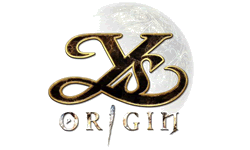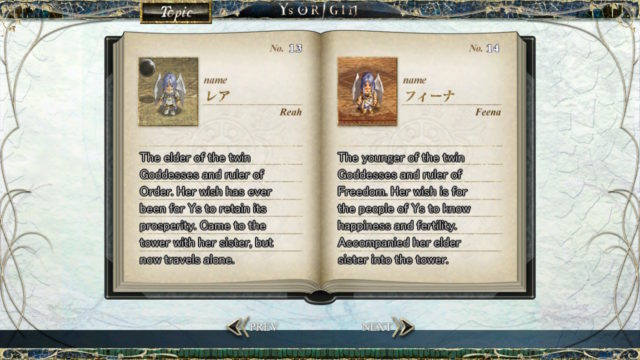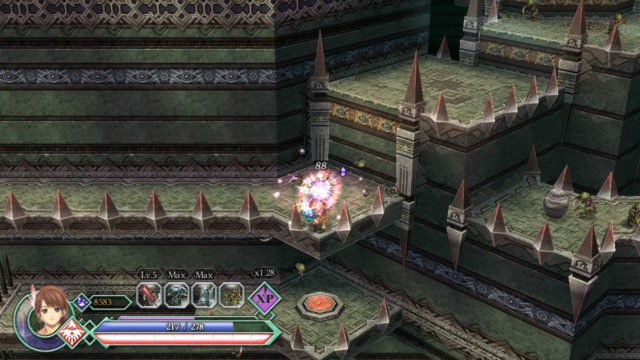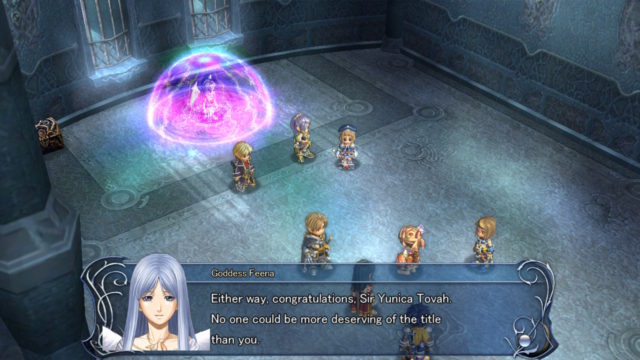Ys Origin Review
Back to the Beginning
700 years before the trials and tribulations of the heroic Adol, the goddesses Feena and Rhea depart from the floating civilization of Solomon Shrine to the world of Ys below, which has become contaminated by demonic energies. Desperate to know why, a search party departs for the surface from the shrine high above to chase after the twin deities. Ys Origin is a simple game in structure: rise through the 25 floors of an eerie tower with one of three characters, and discover the events that eventually led to a slew of adventures for a certain redhead many hundreds of years later. Though the game has some flaws and is starting to show its age, the fast paced combat system and compelling trifecta of stories mean Origin remains a strong title in the Ys series.
The story of Origin is told from three distinct perspectives, though the tales have some overlap. To begin, players have two tales to pursue, but a third becomes available once both are completed. Even though all three characters are climbing the same tower, each story has its own twists and turns inside of a larger tale, making the process of going through them all worthwhile. As a prequel, the story is naturally limited in scope and a little predictable, but does an excellent job carrying multiple playthroughs.
At first, an Ys game starring someone besides Adol seems strange, but it quickly feels at home in the series. How combat works depends on the character being played, but no matter which protagonist is on the climb, combat feels really smooth and there’s an incredible sense of satisfaction of taking down enemies, from the smallest oozling to massive bosses. Yunica is the most similar to Adol. She is a middle-range attacker and lacks magical powers, with her big axe and elemental abilities being her primary weapons. On the other hand, Hugo is a magical prodigy, focusing on long-range attacks, with a limited repertoire of abilities to get enemies out of his face. The third protagonist is a close combat character whose moves focus on mobility and taking out the enemies before any of their strikes land.
Each character has a boost mode that enhances their combat; for Yunica this means a strength boost, along with immunity to some attacks, while for Hugo this means his magical beam-shooting eyes increase from two to four, increasing his damage drastically if all four can be lined up to blast away. Despite each having a distinct style, the sense of enjoyment when mowing down enemies left and right transcends character choice. During the course of a playthrough, players unlock new abilities for their character, one of which offers an important way to traverse the game’s frequent platforming sections. Players will need to combine together these movement skills and well-timed platforming to get to some of the most hard-to-reach places, but being able to open the chest that looked impossible to get is incredibly satisfying.
As the protagonists explore the tower, new gear will become available, though most are slightly off the beaten path, so players will need to explore to find all the equipment available for their character; players should also be on the search for Celcetan Panacea, which provides a permanent HP boost. While missing one of these upgrades isn’t a dealbreaker on the easier modes, every upgrade matters on the higher difficulties. Each piece of equipment can be bolstered by cashing in SP, earned from defeating enemies, at the Goddess statues scattered around the dungeons, though how much of a bonus these upgrades bestow depends on the difficulty chosen. SP can also be used to buff characters in a variety of ways, such as improving resistance to status effects, running faster, or recovering MP for skills rapidly.
Last but not least, the trio of adventurers discover a variety of accessories to facilitate their trek up the tower. Some must be explicitly equipped, such as hallowed chimes that send undead enemies to their final rest, though others do not need to be, such as a ring that unlocks double jumping. Each new feature and function is doled out slowly while progressing up the tower and the flow of upgrades and new features feels brisk without being overwhelming. For anyone who needs a refresher, the easy to use menu has tons of information, including an instruction manual showing all tutorials, a bestiary, as well as both an equipment and item menu. All of this combines together for a fast-paced combination of platforming and real-time combat which players must navigate, but with upgrades, abilities and equipment being rewarded at regular intervals, there’s a hard to describe fun feeling of progressing in Ys Origin. The pacing is excellent and combat is by far the best part of the game and will bring players back to experience all three story perspectives, despite the dungeon layout being identical for all characters.
However, there are some gameplay drawbacks. Strangely, Ys Origin never explicitly states that players can swap between elemental attacks with the Switch’s shoulder buttons, which is important information given the usual method of switching is unavailable during boss encounters. While bosses are all visually unique, defeating them feels quite rote after the first few. As the game lacks healing options, most boss fights boil down to avoiding attacks while getting in lots of charged up special skills.Hitting aerial enemies is challenging with most characters, and executing the downward strike which will force them to land isn’t easy to consistently pull off. Lastly, there’s a fairly significant jump between each difficulty level, and the difficulty can only be chosen at the start of a run, so trying to find the right level of challenge can be a bit hit or miss. While none of these are overall enough to break the gameplay, they are worth noting as a caution to prospective players.
Both visually and aurally, Ys Origin is starting to show its age; what was once a lovely game released over a decade ago on PC is starting to wear a little thin around the edges. The game looks quite smooth in handheld mode, where the smaller size hides some of the blemishes during the story-heavy sections. However, while playing the game docked on a larger television, the anime-style cutscenes start to look a little tired. In terms of music, the sound team at Falcom hasn’t dropped a stitch, but as more expansive music has been seen in the many years since Origin launched in more recent Ys titles, it does feel dated in comparison.
Though the combat has some limitations and the game may be a little frayed around the edges, Ys Origin is absolutely worth a look for anyone who somehow dodged previous releases on PC, PS4, Vita, or Xbox One. It’s also one of the most accessible starting points into the Ys franchise as a whole, and doesn’t require a huge time investment, as most players can finish a single story in about ten to twelve hours, with each progressive playthrough taking slightly less time. For long-time Ys aficionados, it’s neat to see where the lore that has become a staple of the series has its origin.
Disclosure: This review is based on a free copy of the game provided by the publisher.


Fast paced, interesting combat
Good mix of series staples and new ideas
Three character stories comprise one larger narrative
Game is showing its age
Big jumps between difficulty levels









Recent Comments